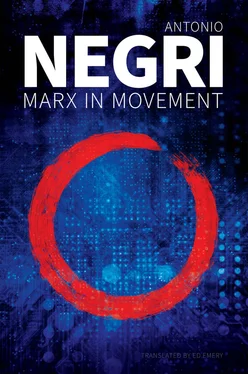2 Capitalist restructuring: From the mass worker to social labour power
So let us return to the moment when the pressure of this new spontaneity (that is, the spontaneous – but, as in the paradox I have described, both structural and structured – forms of expression of the new class composition, i.e. of the mass worker) brings about a crisis in the means of capitalist control over the production and reproduction of commodities.
I would suggest that this moment can be located chronologically within the decade 1960–1970. In that period, strikes and struggles created an upheaval within the existing framework of development, inducing a major series of critical phenomena (crises of capitalist control), of which the following seem to be the most important:
1 The mass worker set in motion a mobility within the labour market. The subversive characteristics of this mobility appear to consist in an uncontrollable increase in the speed of flow and turnover of demands, and at the same time in a rigid and homogeneous escalation of those demands. If we include in our definition of the mass worker the fact that the mass worker represents a certain qualitative solidification of abstract labour (which is another way of saying a high level of subjective awareness of abstract labour), then these mobility-related phenomena reveal simply the centripetal potential of abstract labour (towards averageness, mediety) in a framework of mass production in modern capitalism. And this might be consistent with development. But, instead, the forms and modes in which the mobility (subjectivity) of the mass worker expressed itself threw capitalist development out of proportion, subjected it to intolerable accelerations, and in particular confronted it with the quality of this very composition – those historical differences and divisions of sex, age, culture, and so on that were now tending towards a deeply rooted political homogeneity. Mobility of abstract labour equals tendency for subjects and for struggles to unify.
2 On the other hand, in a complementary process, the mass worker set in motion, both in individual factories and in the productive fabric of the metropolis, a downward rigidity of expectations and wage demands. This in itself (the demand for ‘parity’) became a subversive force. Drives towards egalitarianism served to reinforce this rigidity: we saw the collapse of all – or virtually all – the weaponry of division in the factory (piecework, employers’ unilateral control of timings of the labour process, internal mobility, etc.) and of the hierarchy that controls the labour process and the organization of production. In this period, sackings – together with all the other various forms of exclusion and marginalization – were powerfully contested, resisted, and in large part blocked. Furthermore, the overall rigidity of the class brought about a reduction in effective labour time; it also provided defence and backup for individual experiences of resistance to work or refusal of work. The wage struggle, in both its qualitative and quantitative aspects, became a powerful independent variable of development: a kind of economic–political dual power that came into existence. (In some instances we find this registered in factory legislation – most notably in Italy, for example.) Rigidity of abstract labour equals qualitative consolidation of the previously mentioned unification of subjects and of struggles.
3 Third, the social mobility and the political and wage rigidity of the social worker were also articulated within the sphere of circulation. But, for the mass worker, circulation means a radical change in the relation between daily work time and non-work time. We were not yet at the point where the latter had hegemony over the former. However, this was a phase in which the social relation of production (the relation between production and reproduction) was an area of powerful contestation. Without succeeding in fully controlling and carrying through this leap in the class struggle, mass workers nevertheless spread the infection of their subjective behaviour into the fabric of proletarian society. First – just to take one example – although not yet at the point of directly contesting the ‘Oedipal wage’ (in other words, the wage paid for the male worker’s domination over his family), the mass worker nonetheless induced an awareness of the urgent need for new wage forms in the management and development of the social sphere – new wage forms likely to have a decisive and dissolving effect on the unified family wage and to liberate new labour power at an extremely high level of needs. The mass worker was an active factor in the circulation of working-class objectives and in propagating the equality implicit in abstract labour. As such, the mass worker induced subversive effects within society that tended to negate the division between productive and reproductive labour, and also to alter the established proportion between them. The circulation of the forms of behaviour of the mass worker was an extension of the unification of the subjects and of the struggles.
4 Finally, I have to stress that it is only by moving to a political expression that the series of subversive conditions implicit in the existence of the mass worker could be further advanced. The concept of the mass worker had an existence that was purely relative; the fact that mass workers were the point of a class evolution that had not yet been fully realized often permitted the surreptitious reintroduction of old political concepts and practices, such as the notion of vanguard and mass, and thus permitted the re-emergence of party representation and the mirroring of past forms. This political inadequacy results from precisely the social indeterminateness of the figure of the mass worker. We should never underestimate this limitation but, if we look beyond it, we can see that a framework of new values was beginning to take shape – ideas of freedom to match the fact of mobility; ideas of community, as an aspect of the rigidity mentioned; ideas of new life and universality, as a synthesis of people’s relation to reproduction and liberated time. This framework of new values was incipient, was still dawning, but was nonetheless efficacious, because it existed at a mass level.
At this point the capitalist crisis in the management of this labour power, with all its strength and richness, became decisive. Capital goes into crisis every time labour power transmutes to become working class – and by ‘working class’ I mean a level of composition incompatible with command, at a given historical level of maturity of the productive forces. (It is evident that consciousness cannot be defined outside this relation; so it is possible to find extremely high levels of consciousness that remain totally ineffective and, on the other hand, spontaneous levels of consciousness that are powerfully effective in revolutionary terms.) As I say, every time when labour power effects a revolutionary transformation in its composition and becomes working class, at that point capital enters relations of crisis and has only one weapon with which to respond: restructuring – an attempt to attack and transform class composition. In other words, for capital, restructuring is a political, economic and technological mechanism aimed at the enforced reduction of the working class to labour power. To put it more correctly, capital aims to reduce the intensity of the political composition of the class.
At this point, the problem becomes specific again. How did capital respond to the crisis in relations of production that was induced by the class offensive of the mass worker? How was restructuring articulated at this level of political composition of the class and its struggles? What happened after the 1960s?
Читать дальше












